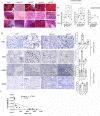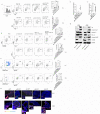Cell membrane-anchored and tumor-targeted IL-12 T-cell therapy destroys cancer-associated fibroblasts and disrupts extracellular matrix in heterogenous osteosarcoma xenograft models
- PMID: 38199607
- PMCID: PMC10806671
- DOI: 10.1136/jitc-2023-006991
Cell membrane-anchored and tumor-targeted IL-12 T-cell therapy destroys cancer-associated fibroblasts and disrupts extracellular matrix in heterogenous osteosarcoma xenograft models
Abstract
Background: The extracellular matrix (ECM) and cancer-associated fibroblasts (CAFs) play major roles in tumor progression, metastasis, and the poor response of many solid tumors to immunotherapy. CAF-targeted chimeric antigen receptor-T cell therapy cannot infiltrate ECM-rich tumors such as osteosarcoma.
Method: In this study, we used RNA sequencing to assess whether the recently invented membrane-anchored and tumor-targeted IL-12-armed (attIL12) T cells, which bind cell-surface vimentin (CSV) on tumor cells, could destroy CAFs to disrupt the ECM. We established an in vitro model of the interaction between osteosarcoma CAFs and attIL12-T cells to uncover the underlying mechanism by which attIL12-T cells penetrate stroma-enriched osteosarcoma tumors.
Results: RNA sequencing demonstrated that attIL12-T cell treatment altered ECM-related gene expression. Immunohistochemistry staining revealed disruption or elimination of high-density CAFs and ECM in osteosarcoma xenograft tumors following attIL12-T cell treatment, and CAF/ECM density was inversely correlated with T-cell infiltration. Other IL12-armed T cells, such as wild-type IL-12-targeted or tumor-targeted IL-12-T cells, did not disrupt the ECM because this effect depended on the engagement between CSV on the tumor cell and its ligand on the attIL12-T cells. Mechanistic studies found that attIL12-T cell treatment elevated IFNγ production on interacting with CSV+ tumor cells, suppressing transforming growth factor beta secretion and in turn upregulating FAS-mediated CAF apoptosis. CAF destruction reshaped the tumor stroma to favor T-cell infiltration and tumor inhibition.
Conclusions: This study unveiled a novel therapy-attIL12-T cells-for targeting CAFs/ECM. These findings are highly relevant to humans because CAFs are abundant in human osteosarcoma.
Keywords: Cytokines; Immunotherapy, Adoptive; Lymphocytes, Tumor-Infiltrating; Pediatrics; Tumor Microenvironment.
© Author(s) (or their employer(s)) 2024. Re-use permitted under CC BY-NC. No commercial re-use. See rights and permissions. Published by BMJ.
Conflict of interest statement
Competing interests: No, there are no competing interests.
Figures






References
Publication types
MeSH terms
Substances
Grants and funding
LinkOut - more resources
Full Text Sources
Medical
Research Materials
Miscellaneous
